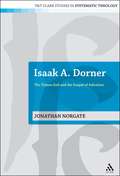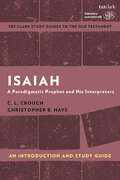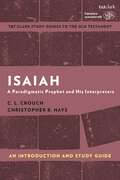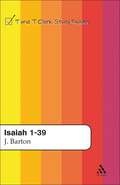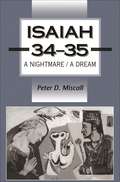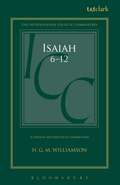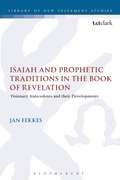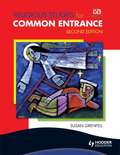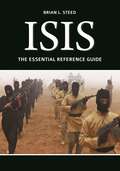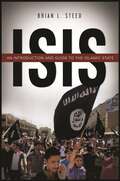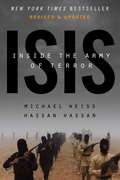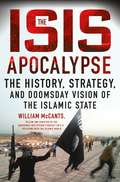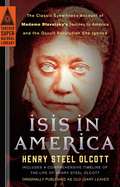- Table View
- List View
Isaak A. Dorner: The Triune God and the Gospel of Salvation (T&T Clark Studies in Systematic Theology)
by Jonathan NorgateNorgate assesses the way in which the Christian doctrine of the Trinity is the foundation for all other Christian doctrines, especially the Christian understanding of salvation. He investigates in detail the approach of the German Lutheran theologian, Isaac A. Dorner (1809-1884) to this question. Analysis of his arguments concerning the priority of the doctrine of God for Christian belief and dogmatics is given. It examines the form of his doctrine of God's triunity, and gives an extensive study of how Dorner's particular account of God's triune identity informs the Christian conception of God's relation to the world, first, as Creator and, second, as Saviour. In this process, it seeks to refocus attention on Dorner as a major figure in the development of modern theology. The relationship between Dorner's doctrines of the triune God and salvation is assesed. Dorner's positive reconstruction of the Christian idea of God as Trinity provides helpful resources in delineating a non-competitive account of God's relation to the world. This means that God is not confused with nor distant from the world. The eternal vitality of God's immanent personality is the basis of His vital economic activity, which culminates in the incarnation of the Son. We follow the main tributories of Dorner's arguments in System of Christian Faith, beginning with an analysis of his doctrine of God, via his development of the doctrines of creation, humanity, and the incarnation of the God-man. An assessment is given of those doctrines which pertain to the way in which God brings salvation through Jesus Christ: sin, Jesus, and atonement. Norgate concludes by comparing Dorner's achievements with those found in more recent theologies of atonement.
Isaak A. Dorner: The Triune God and the Gospel of Salvation (T&T Clark Studies in Systematic Theology #3)
by Jonathan NorgateNorgate assesses the way in which the Christian doctrine of the Trinity is the foundation for all other Christian doctrines, especially the Christian understanding of salvation. He investigates in detail the approach of the German Lutheran theologian, Isaac A. Dorner (1809-1884) to this question. Analysis of his arguments concerning the priority of the doctrine of God for Christian belief and dogmatics is given. It examines the form of his doctrine of God's triunity, and gives an extensive study of how Dorner's particular account of God's triune identity informs the Christian conception of God's relation to the world, first, as Creator and, second, as Saviour. In this process, it seeks to refocus attention on Dorner as a major figure in the development of modern theology. The relationship between Dorner's doctrines of the triune God and salvation is assesed. Dorner's positive reconstruction of the Christian idea of God as Trinity provides helpful resources in delineating a non-competitive account of God's relation to the world. This means that God is not confused with nor distant from the world. The eternal vitality of God's immanent personality is the basis of His vital economic activity, which culminates in the incarnation of the Son. We follow the main tributories of Dorner's arguments in System of Christian Faith, beginning with an analysis of his doctrine of God, via his development of the doctrines of creation, humanity, and the incarnation of the God-man. An assessment is given of those doctrines which pertain to the way in which God brings salvation through Jesus Christ: sin, Jesus, and atonement. Norgate concludes by comparing Dorner's achievements with those found in more recent theologies of atonement.
Isaiah: A Paradigmatic Prophet and His Interpreters (T&T Clark’s Study Guides to the Old Testament)
by C.L. Crouch Christopher B. HaysC. L. Crouch and Christopher B. Hays introduce the Book of Isaiah in its diverse historical contexts, tracing its origins and development over several centuries: beginning with the career of the prophet Isaiah ben Amoz in eighth century Jerusalem, continuing with a late seventh century edition and the further revisions made in the late sixth century, and concluding with final shaping during the Persian Period. At each stage Crouch and Hays pay close attention to the historical, cultural, and theological conversations that influenced the book's aims and interests. Crouch and Hays discuss the theological and literary continuities among the book's contributors, as well as where language and concerns differed from generation to generation. They also consider the reception history of Isaiah and what the text has meant to people through history. With suggestions of further reading at the end of each chapter, this guide will be an essential accompaniment to study of the Book of Isaiah.
Isaiah: A Paradigmatic Prophet and His Interpreters (T&T Clark’s Study Guides to the Old Testament)
by C.L. Crouch Christopher B. HaysC. L. Crouch and Christopher B. Hays introduce the Book of Isaiah in its diverse historical contexts, tracing its origins and development over several centuries: beginning with the career of the prophet Isaiah ben Amoz in eighth century Jerusalem, continuing with a late seventh century edition and the further revisions made in the late sixth century, and concluding with final shaping during the Persian Period. At each stage Crouch and Hays pay close attention to the historical, cultural, and theological conversations that influenced the book's aims and interests. Crouch and Hays discuss the theological and literary continuities among the book's contributors, as well as where language and concerns differed from generation to generation. They also consider the reception history of Isaiah and what the text has meant to people through history. With suggestions of further reading at the end of each chapter, this guide will be an essential accompaniment to study of the Book of Isaiah.
Isaiah 1-39 (T&T Clark Study Guides)
by John BartonOriginally published as part of the acclaimed Sheffield Guides series, this helpful study-guide is designed to meet the needs of students and general readers in a concise, accessible and affordable format. The complete set of books will offer a comprehensive introduction to the Bible and related writings. Each study-guide comprises-An Introduction to the content and message of the particular book-A survey of the significant critical issues-An assesment of recent scholarship-Signposts towards major critical works in the area-Annotated bibliographiesT & T Clark Study Guides are written by some of the world's greatest biblical scholars, each of whom draws on their extensive teaching experience to make their subject come alive for all who are approaching biblical studies for the first time.
Isaiah 1-5: A Critical and Exegetical Commentary (International Critical Commentary)
by H.G.M. WilliamsonHugh Williamson's Isaiah 1-5 is the first of three volumes in a important new commentary on Isiah 1-27. For over one hundred years International Critical Commentaries have had a special place among works on the Bible. They bring together all the relevant aids to exegesis - linguistic, textual, archaeological, historical, literary, and theological - to help the reader understand the meaning of the books of the Old and New Testaments. The new commentaries continue this tradition. All new evidence now available is incorporated and new methods of study are applied. The authors are of the highest international standing. No attempt has been made to secure a uniform theological or critical approach to the biblical text: contributors have been invited for their scholarly distinction, not for their adherence to any one school of thought.
Isaiah 34-35: A Nightmare/A Dream (The Library of Hebrew Bible/Old Testament Studies)
by Peter D. MiscallBy a poetic analysis of Isaiah 34-35 as a single poem, the reading explores in depth its imagery, themes and structure. Attention to detail is combined with wide-ranging discussions of reading and interpretation, which revolve around the contrasting, and strangely interrelated, scenes of destruction (nightmare) and restoration (dream) found in the two parts of the poem. The poem emerges as an integral part of Isaiah, which is treated as a single work. The consistency is revealed in parallel terms, images and structure. Implications of the analysis and mode of reading for the whole of Isaiah are commented on throughout.
Isaiah 40-55 Vol 1: A Critical and Exegetical Commentary (International Critical Commentary)
by John Goldingay David PayneFor over one hundred years International Critical Commentaries have had a special place among works on the Bible. They bring together all the relevant aids to exegesis - linguistic, textual, archaeological, historical, literary, and theological - to help the reader understand the meaning of the books of the Old and New Testaments. The new commentaries continue this tradition. All new evidence now available is incorporated and new methods of study are applied. The authors are of the highest international standing. No attempt has been made to secure a uniform theological or critical approach to the biblical text: contributors have been invited for their scholarly distinction, not for their adherence to any one school of thought.
Isaiah 40-55 Vol 2: A Critical and Exegetical Commentary (International Critical Commentary)
by John Goldingay David PayneFor over one hundred years International Critical Commentaries have had a special place among works on the Bible. They bring together all the relevant aids to exegesis - linguistic, textual, archaeological, historical, literary, and theological - to help the reader understand the meaning of the books of the Old and New Testaments. The new commentaries continue this tradition. All new evidence now available is incorporated and new methods of study are applied. The authors are of the highest international standing. No attempt has been made to secure a uniform theological or critical approach to the biblical text: contributors have been invited for their scholarly distinction, not for their adherence to any one school of thought.
Isaiah 6-12: A Critical and Exegetical Commentary (International Critical Commentary)
by H.G.M. WilliamsonThis eagerly anticipated volume is the second installment in H.G.M. Williamson's International Critical Commentary on first Isaiah. For over one hundred years International Critical Commentaries have had a special place among works on the Bible. They bring together all the relevant aids to exegesis - linguistic, textual, archaeological, historical, literary, and theological - to help the reader understand the meaning of the books of the Old and New Testaments.Williamson continues in this tradition, adding to his already published volume on Isaiah 1-5. Covering the next seven chapters of Isaiah Williamson incorporates a range of secondary scholarly material with examination of all the key textual and critical issues surrounding the text.
Isaiah and Prophetic Traditions in the Book of Revelation: Visionary Antecedents and their Development (The Library of New Testament Studies #93)
by Jan Fekkes IIIThis work is concerned with the influence of biblical and prophetic traditions on the author of the book of Revelation, and in particular his use of the prophecies of Isaiah. First, John's own prophetic consciousness and expression is compared with previous Israelite-Jewish and early Christian prophetic conventions. This is followed by an evaluation of John's use of the OT in general, including a discussion of methodology for isolating allusions, the question of the validity of the terms quotation and allusion in Revelation, and the presence of thematic patterns in the author's choice of Scripture. All this is foundational to the main portion of the work (Ch. III), where a detailed analysis is undertaken to determine the validity of all proposed allusions to Isaiah in the book of Revelation. Of the 72 suggested allusions treated, 40 were judged as certain or virtually certain, 24 were considered as unlikely or doubtful, and 8 were appraised as probable or possible. Those allusions which were accepted received further evaluation to see how and why they were used by John, with special attention given to the tradition-history of the passage used, and the possible interpretative techniques employed. A variety of exegetical and literary devices were uncovered, including the use of catchwords, inclusio, repetition of texts, exploitation of Hebrew parallelism, and the collection of texts around a central theme. Furthermore, John's use of Isaiah is concentrated in basic areas, with clusters of Isaiah texts appearing in specific sections of Revelation. The principal Isaian themes with which he is interested are holy war and the Day of the Lord, oracles against the nations, and salvation prophecies relating to the community of faith and the restored and glorified Jerusalem. It was concluded that on the whole, John's use of Isaiah is not random, and he does not use the OT texts merely as a visionary resource for language, phrases, structural patterns etc. But he consciously carries on the prophecies of his biblical predecessors and invokes their authority. The remnants and results of John's interpretation of Isaiah presuppose exegetical activity and application prior to the vision experience and it is likely that at least some of his intended readers were familiar not only with his theological concerns, but also with his methodological approach.
Isaiah Berlin: The Journey of a Jewish Liberal (Palgrave Studies in Cultural and Intellectual History)
by A. DubnovThis study offers an intellectual biography of the philosopher, political thinker, and historian of ideas Sir Isaiah Berlin. It aims to provide the first historically contextualized monographic study of Berlin's formative years and identify different stages in his intellectual development, allowing a reappraisal of his theory of liberalism.
Isaiah in the New Testament: The New Testament and the Scriptures of Israel
by Steve Moyise Maarten J.J. MenkenIsaiah in the New Testament brings together a set of specially commissioned studies by authors who are experts in their field. Beginning with an introductory chapter on the use of Isaiah in the Dead Sea Scrolls and Second Temple literature, contributors go on to discuss each of the New Testament books that contain quotations from Isaiah: Matthew, Mark, (Q), Luke-Acts, John, Romans and Galatians, 1 and 2 Corinthians, Hebrews, 1 Peter and Revelation. Together they provide an overview of the status, role and function of Isaiah in the first century, considering the Greek and Hebrew manuscript traditions and offering insights into the various hermeneutical stances of the New Testament authors and the development of New Testament theology. The volume includes contributions from Darrell Hannah, Morna Hooker, Christopher Tuckett, Richard Beaton, Bart Koet, Catrin Williams, J. Ross Wagner, Florian Wilk, Cecil McCullough, Steve Moyise and David Mathewson.
Isaiah Through the Centuries (Wiley Blackwell Bible Commentaries)
by John F. SawyerThe first systematic and comprehensive attempt to identify and analyze the role of Isaianic language and imagery in literature, art, and music Using reception history as its basis for study, Isaiah Through the Centuries is an unprecedented exploration of the afterlife of the Book of Isaiah, specifically in art, literature, and music. This is a commentary that guides the reader through the Book of Isaiah, examining the differing interpretations of each phrase or passage from a variety of cultural and religious perspectives, Jewish, Christian and Muslim. Clearly structured and accessible, and richly illustrated, the book functions as a complete and comprehensive educational reference work. Isaiah Through the Centuries encourages readers to learn with an open mind and to understand how different interpretations have helped in the teaching and comprehension of the Bible and Isaiah’s place in it. As part of the Wiley-Blackwell Bible Commentaries series, which is primarily concerned with reception history, the book emphasizes that how people interpret the prophet—and how they’ve been influenced by him—is often just as important as the sacred text’s original meaning. Uses reception history to study the renowned prophet Provides a historical context for every use or interpretation discussed Offers essential background information on authors, artists, musicians, etc. in its glossary and biographies Minimizes historical details in order to focus as much as possible on exegetical matters Presents the role of Isaiah and the Bible in the creative arts Will be useful to multiple disciplines including theology and religion, English literature, art history and the history of music, not just Biblical Studies Comprehensive in scope, Isaiah Through the Centuries is a much-needed resource for all those interested in the influence of the Bible on Western culture, and presents unique perspectives for anyone interested in the Bible to discuss and debate for many years to come.
Isaiah Through the Centuries (Wiley Blackwell Bible Commentaries)
by John F. SawyerThe first systematic and comprehensive attempt to identify and analyze the role of Isaianic language and imagery in literature, art, and music Using reception history as its basis for study, Isaiah Through the Centuries is an unprecedented exploration of the afterlife of the Book of Isaiah, specifically in art, literature, and music. This is a commentary that guides the reader through the Book of Isaiah, examining the differing interpretations of each phrase or passage from a variety of cultural and religious perspectives, Jewish, Christian and Muslim. Clearly structured and accessible, and richly illustrated, the book functions as a complete and comprehensive educational reference work. Isaiah Through the Centuries encourages readers to learn with an open mind and to understand how different interpretations have helped in the teaching and comprehension of the Bible and Isaiah’s place in it. As part of the Wiley-Blackwell Bible Commentaries series, which is primarily concerned with reception history, the book emphasizes that how people interpret the prophet—and how they’ve been influenced by him—is often just as important as the sacred text’s original meaning. Uses reception history to study the renowned prophet Provides a historical context for every use or interpretation discussed Offers essential background information on authors, artists, musicians, etc. in its glossary and biographies Minimizes historical details in order to focus as much as possible on exegetical matters Presents the role of Isaiah and the Bible in the creative arts Will be useful to multiple disciplines including theology and religion, English literature, art history and the history of music, not just Biblical Studies Comprehensive in scope, Isaiah Through the Centuries is a much-needed resource for all those interested in the influence of the Bible on Western culture, and presents unique perspectives for anyone interested in the Bible to discuss and debate for many years to come.
Isaiah's Vision of Peace in Biblical and Modern International Relations: Swords into Plowshares (Culture and Religion in International Relations)
by R. Cohen R. WestbrookThe aim of this volume is to try to account for Isaiah's revolutionary vision from two disciplinary perspectives: one approach is the historical study of the Ancient Near East and the Bible, and the other rests on the study of international relations from a comparative, conceptual perspective.
ISEB Religious Studies for Common Entrance: Pupil's Book (PDF)
by Susan GrenfellAn authoritative textbook to prepare pupils for the compulsory sections of the Independent Schools Examination Board's (ISEB) Common Entrance Religious Studies examination. Updated and revised to reflect the latest syllabus, this book covers all the nominated Old Testament and New Testament texts through an investigative approach, providing active learning for the classroom as well as tasks for independent study and revision.nbsp;
ISIS: The State of Terror
by J. M. Berger Jessica SternThe first major book on ISIS to be published since the group exploded on the international stage in summer 2014. Drawing on their unusual access to intelligence sources and material, law enforcement, and groundbreaking research into open source intelligence, Stern and Berger outline the origins of ISIS as the formidable terrorist group it has quickly become. 9780008120931 9780008120948
ISIS: The Essential Reference Guide
by Brian L. SteedThis illuminating work offers readers a comprehensive overview of ISIS, with more than 100 in-depth articles on a variety of topics related to the notorious terrorist group, and more than a dozen key primary source documents.ISIS formed through a combination of a rise in violent extremist ideologies demonstrated on September 11, 2001; the invasion of Iraq; and the Syrian Civil War. ISIS is possibly the most important conflict group and phenomena of the last half century, and understanding its source and success is crucial to functioning in the world today. This book provides insight into ISIS from its beginnings to the present, through coverage of its people, organizations, and operations.The book begins with an overview of ISIS, which provides context for each of the reference entries that follow. The introductory material also includes entries on the causes and consequences of the conflict between ISIS and the West. The book contains more than 100 reference entries on general and specific topics ranging from key leaders to major terrorist attacks and affiliated organizations. It also includes a carefully curated selection of primary sources that come from a variety of sources including national-level strategy documents, presidential addresses, and ISIS itself. The book concludes with a detailed chronology and annotated bibliography.
ISIS: The Essential Reference Guide
by Brian L. SteedThis illuminating work offers readers a comprehensive overview of ISIS, with more than 100 in-depth articles on a variety of topics related to the notorious terrorist group, and more than a dozen key primary source documents.ISIS formed through a combination of a rise in violent extremist ideologies demonstrated on September 11, 2001; the invasion of Iraq; and the Syrian Civil War. ISIS is possibly the most important conflict group and phenomena of the last half century, and understanding its source and success is crucial to functioning in the world today. This book provides insight into ISIS from its beginnings to the present, through coverage of its people, organizations, and operations.The book begins with an overview of ISIS, which provides context for each of the reference entries that follow. The introductory material also includes entries on the causes and consequences of the conflict between ISIS and the West. The book contains more than 100 reference entries on general and specific topics ranging from key leaders to major terrorist attacks and affiliated organizations. It also includes a carefully curated selection of primary sources that come from a variety of sources including national-level strategy documents, presidential addresses, and ISIS itself. The book concludes with a detailed chronology and annotated bibliography.
ISIS: An Introduction and Guide to the Islamic State
by Brian L. SteedProviding up-to-date information for general readers as well as those well-informed about the Islamic State, this book offers an essential understanding of the rise of ISIS and its current influence in the Middle East as well as worldwide.ISIS—also referred to as ISIL, the Islamic State, or Daesh—began to assert its power and gain recognition for its militant and terroristic activities in April 2013. After the coordinated attacks in Paris on November 13th, 2015, ISIS has captured the full attention of observers in the West. This accessible book explains what ISIS is, what the group's goals are, what their members believe, and why their ranks are growing. Readers will gain an understanding of how ISIS is a unique group—one seeking to be the army of the righteous fighting to defeat the unbelievers and usher in the end of days—but that the extremist views of ISIS are an expression of a growing frustration with life in the Middle East and elsewhere shared by a larger community of non-state and post-state actors.The book provides an introduction that documents the origins of ISIS within the larger Al Qaeda organization during the Iraq War. The following chapters discuss the origins, development, and territorial expansion of ISIS in Syria and Iraq and examine the ideological motivations behind the emergence of ISIS, thereby enabling a nuanced understanding of the importance of ISIS in contemporary history. Other entries discuss individuals, events, and organizations that put ISIS in historical context in terms of contemporary events since the Iraq War into the present and explain the group's position within the complex conflict currently boiling in the Middle East.
ISIS: An Introduction and Guide to the Islamic State
by Brian L. SteedProviding up-to-date information for general readers as well as those well-informed about the Islamic State, this book offers an essential understanding of the rise of ISIS and its current influence in the Middle East as well as worldwide.ISIS—also referred to as ISIL, the Islamic State, or Daesh—began to assert its power and gain recognition for its militant and terroristic activities in April 2013. After the coordinated attacks in Paris on November 13th, 2015, ISIS has captured the full attention of observers in the West. This accessible book explains what ISIS is, what the group's goals are, what their members believe, and why their ranks are growing. Readers will gain an understanding of how ISIS is a unique group—one seeking to be the army of the righteous fighting to defeat the unbelievers and usher in the end of days—but that the extremist views of ISIS are an expression of a growing frustration with life in the Middle East and elsewhere shared by a larger community of non-state and post-state actors.The book provides an introduction that documents the origins of ISIS within the larger Al Qaeda organization during the Iraq War. The following chapters discuss the origins, development, and territorial expansion of ISIS in Syria and Iraq and examine the ideological motivations behind the emergence of ISIS, thereby enabling a nuanced understanding of the importance of ISIS in contemporary history. Other entries discuss individuals, events, and organizations that put ISIS in historical context in terms of contemporary events since the Iraq War into the present and explain the group's position within the complex conflict currently boiling in the Middle East.
ISIS: Inside The Army Of Terror (updated Edition) (PDF)
by Michael Weiss Hassan HassanFully Revised & Updated Edition of the New York Times Bestselling and Highly Praised Book on ISIS With newly added material and breaking news including: --Interview with a former ISIS spymaster --Why ISIS is targeting Europe and the US --What Russia wants in Syria --Revelations on the brutal ideology of ISIS With brutal attacks in last year across the globe--Brussels, Paris, Beirut, Egypt, Turkey--the Islamic State of Iraq and Syria (ISIS) has proved itself the greatest terrorist threat in the world today. They have conquered massive territories in Syria and Iraq in a bid to create a new Muslim caliphate under the strict dictates of Sharia law. In this fully revised and updated edition of ISIS: Inside the Army of Terror, American journalist Michael Weiss and Syrian analyst Hassan Hassan explain how these violent extremists evolved from a nearly defeated Iraqi insurgent group into a jihadi army of international volunteers who, with slickly produced murder videos, are spreading violence and mayhem across the globe. Beginning with the early days of Abu Musab al-Zarqawi, the founder of ISIS's first incarnation, Weiss and Hassan explain who the key players are--from their leader Abu Bakr al-Baghdadi to the former Saddam Baathists in their ranks--where they come from, how they have attracted both local and global support, and how they operate--from their social media strategy to their illicit oil revenues. As money and mat#65533;riel continue to flow into the region to combat the ISIS's spreading terror, other forces--Assad's regime, Russian planes, Iranian Quds Forces, and other Shiite militias--are gaining power and using the fight against ISIS as a means to leverage their agenda in the region. Political and military maneuvering by the United States, Iraq, Iran, Syria, and Russia have fueled ISIS's explosive expansion. In five new chapters, the authors delve further into the inner workings of the Army of Terror and what it is like to live under their ever-tightening rule. With invaluable and exclusive insider information, the authors explore the Islamic State's enigmatic recruitment and training methods, the impact of their military successes and failures, and how they structure and empower home-grown cells worldwide to carry out their terror. Drawing on original interviews with former US military officials and current ISIS fighters--and brand-new interviews with a former ISIS spy, as well as Kurdish and Yazidi survivors of the ISIS's assault on northern Iraq--the authors reveal the internecine struggles within the movement itself, as well as ISIS's bloody hatred of Shiite Muslims, which is generating another sectarian war in the region. A new generation of terror has dawned in the world and to understand how to stop it, we must understand who they are.
The ISIS Apocalypse: The History, Strategy, and Doomsday Vision of the Islamic State (PDF)
by William MccantsThe Islamic State is one of the most lethal and successful jihadist groups in modern history, surpassing even al-Qaeda. Thousands of its followers have marched across Syria and Iraq, subjugating millions, enslaving women, beheading captives, and daring anyone to stop them. Thousands more have spread terror beyond the Middle East under the Islamic State's black flag. How did the Islamic State attract so many followers and conquer so much land? By being more ruthless, more apocalyptic, and more devoted to state-building than its competitors. The shrewd leaders of the Islamic State combined two of the most powerful yet contradictory ideas in Islam-the return of the Islamic Empire and the end of the world-into a mission and a message that shapes its strategy and inspires its army of zealous fighters. They have defied conventional thinking about how to wage wars and win recruits. Even if the Islamic State is defeated, jihadist terrorism will never be the same. Based almost entirely on primary sources in Arabic-including ancient religious texts and secret al-Qaeda and Islamic State letters that few have seen - William McCants'The ISIS Apocalypse explores how religious fervor, strategic calculation, and doomsday prophecy shaped the Islamic State's past and foreshadow its dark future. 9781466892705 9781250112644
Isis in America: The Classic Eyewitness Account of Madame Blavatsky's Journey to America and the Occult Revolution She Ignited (Tarcher Supernatural Library)
by Henry OlcottTheosophical Society cofounder Colonel Henry Steel Olcott's memoirs cover his years with Madame Helena Petrovna Blavatsky and the birth of the American occult--part of the new Tarcher Supernatural Library. <P><P> There are few more intriguing, or polarizing, figures in modern American spiritual history than Madame Helena Petrovna Blavatsky. The cofounder of the Theosophical Society, Blavatsky remains a figure of fascination more than a century after her death. In Isis in America--one of the most unique documents of recent American spiritual history--we get a closer look at Blavatsky, through the eyes of Theosophical Society cofounder, writer, lawyer, investigator, and Blavatsky confidant Henry Steel Olcott. Olcott spent years by Blavatsky's side, witnessing acts of aura projection and spontaneously produced objects--and undergoing his own spiritual awakening--as they laid the foundations for a new era in esoteric spirituality. This special edition features a comprehensive timeline of the life of Henry Steel Olcott by Mitch Horowitz. <P><P> The first three titles released in Tarcher's Supernatural Library are Ghost Hunter (by Hans Holzer), Romance of Sorcery (by Sax Rohmer) and Isis in America (by Henry Steel Olcott).
